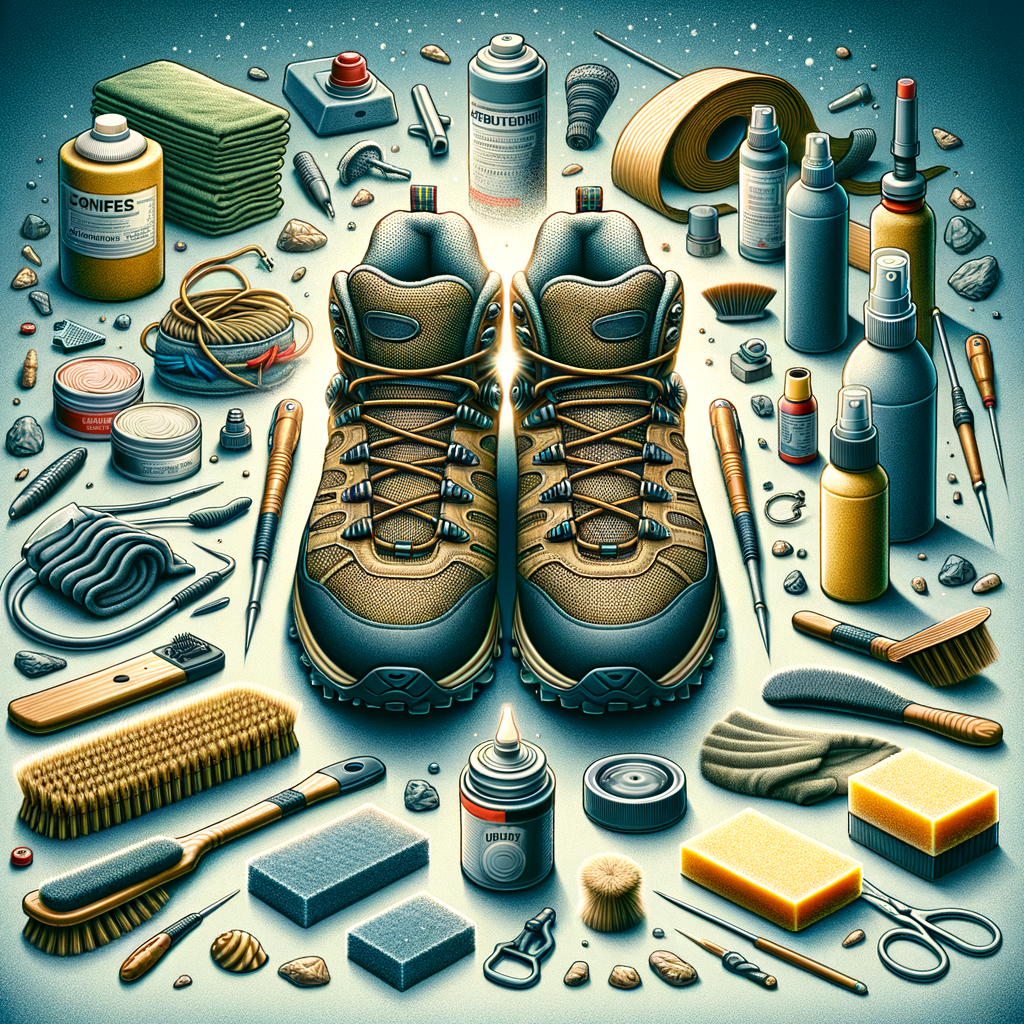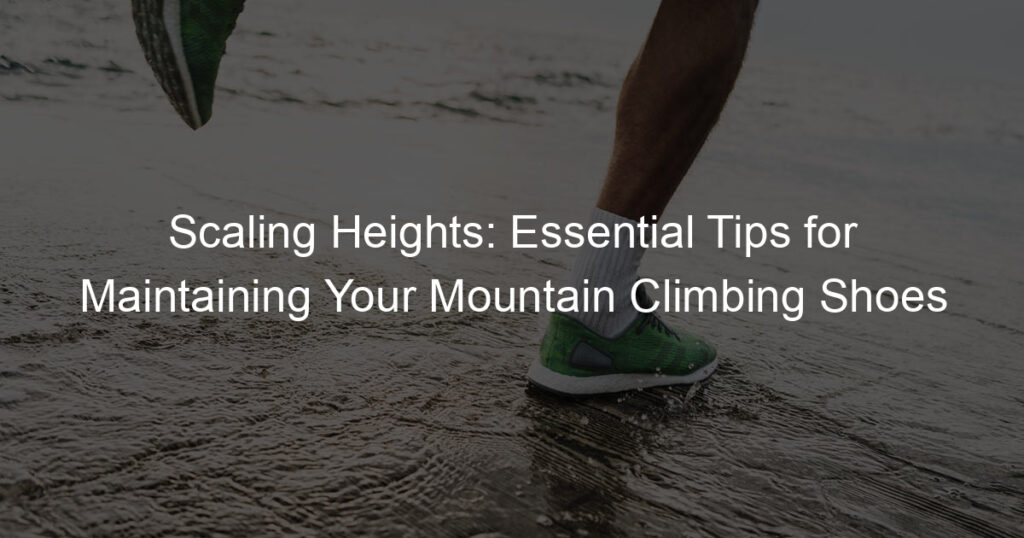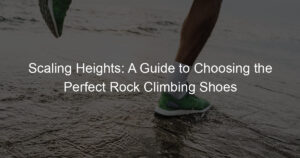
Introduction to Mountain Climbing Footwear Maintenance
Mountain climbing is an exciting adventure that tests your strength, endurance, and courage. But to conquer those towering peaks, you need reliable gear, especially your shoes. Let’s dive into the world of mountain climbing footwear maintenance and understand why it’s so crucial.
- Importance of proper footwear maintenance
- Impact on performance and safety
Mountain climbing shoes are your best friends on those rocky terrains. They protect your feet, provide grip, and help you keep balance. But like any other equipment, they need proper care. Regular maintenance can extend their lifespan, saving you money in the long run. Plus, well-maintained shoes are more comfortable to wear, reducing the risk of blisters and other foot problems.
Did you know that the condition of your shoes can directly impact your climbing performance and safety? Worn-out shoes can lose their grip, making you more likely to slip or fall. On the other hand, well-maintained shoes provide excellent traction, even on slippery surfaces. They also offer better foot support, reducing the risk of injuries. So, if you want to climb higher and safer, don’t neglect your shoe maintenance!
Now that you understand the importance of mountain climbing footwear maintenance, let’s explore how to take care of your shoes properly in the following sections. Remember, your shoes are your foundation when you’re climbing. Treat them well, and they’ll take you to great heights!
Understanding Your Mountain Climbing Shoes
Mountain climbing shoes are a crucial part of your gear. They keep your feet safe and help you climb better. But do you know what they’re made of and how they’re built? Let’s find out!
Materials and Construction
Mountain climbing shoes are made from different materials and built in special ways. This affects how you need to take care of them. Let’s break it down.
- Different materials used in mountain climbing shoes
- How construction affects maintenance needs
Mountain climbing shoes are usually made of leather, synthetic materials, or a mix of both. Leather shoes are durable and can be shaped to your feet. Synthetic shoes are lighter and dry faster. Some shoes even have rubber parts for better grip!
The way your shoes are built can change how you need to care for them. For example, shoes with stitched soles might need to be repaired by a professional if the stitching comes loose. On the other hand, shoes with glued soles can be fixed with special glue. Always check how your shoes are made before you try to fix them yourself.
Understanding your mountain climbing shoes can help you take better care of them. This way, they’ll last longer and you can enjoy your climbs without worrying about your shoes!
Types of Mountain Climbing Shoes
When it comes to mountain climbing, the right footwear can make a huge difference. There are three main types of shoes you might consider: approach shoes, climbing shoes, and mountaineering boots. Each type has its unique features and uses.
- Approach Shoes
- Climbing Shoes
- Mountaineering Boots
Approach shoes are a hybrid between hiking boots and climbing shoes. They are designed to be comfortable for long walks but also have sticky rubber soles for climbing. These shoes are perfect for rocky terrains and are often used by climbers to reach their climbing spot.
Climbing shoes are specifically designed for rock climbing. They have a tight fit and a pointed toe to help climbers grip onto small footholds. The rubber soles are very sticky to provide excellent traction. Climbing shoes are not meant for long walks or hikes, but they are essential for challenging climbs.
Mountaineering boots are designed for high altitude and extreme weather conditions. They are usually waterproof and insulated to keep your feet warm and dry. These boots also have stiff soles for crampon compatibility. If you’re planning a trip to the high mountains, these boots are a must-have.
Remember, the right shoe can make your climbing experience safer and more enjoyable. So, make sure to choose the right type based on your needs and the nature of your climb.
Essential Mountain Climbing Shoes Upkeep Tips
Mountain climbing shoes are a crucial part of your gear. They protect your feet and provide the grip you need to climb safely. But, like any other equipment, they need proper care and maintenance. Here are some essential tips to keep your shoes in top shape.
Cleaning
Cleaning your mountain climbing shoes regularly is the first step to maintaining them. Dirt and grime can damage the material and reduce their lifespan. Here’s how to clean them properly:
- Proper cleaning techniques
- Products to use and avoid
First, remove any loose dirt from the shoes. You can do this by knocking the soles together or using a soft brush. Then, use a damp cloth to wipe the shoes. If they are very dirty, you can use a mild soap. Rinse them thoroughly and let them air dry. Never use a heat source to dry your shoes as it can damage the material.
When cleaning your shoes, it’s best to use products designed for outdoor footwear. These products are gentle and won’t damage the material. Avoid using harsh chemicals or abrasive cleaners as they can cause harm to your shoes. Also, never use a washing machine to clean your shoes as it can cause them to lose their shape and damage the material.
Remember, regular cleaning can help prolong the life of your mountain climbing shoes. So, make it a habit to clean them after every climb.
Storage
Keeping your mountain climbing shoes in good condition is not just about cleaning them properly. How you store them also matters a lot. Here are some tips and common mistakes to avoid when storing your shoes.
- Best Practices for Storing Mountain Climbing Shoes
- Keep them dry: Always ensure your shoes are completely dry before storing them. This helps to prevent the growth of mold and mildew.
- Store in a cool, dry place: Heat and moisture can damage your shoes. Avoid storing them in places like a damp basement or a hot attic.
- Don’t stack them: Stacking shoes can cause them to lose their shape. Instead, place them side by side.
- Use a shoe bag or box: A shoe bag or box can protect your shoes from dust and other potential damage.
- Common Storage Mistakes to Avoid
- Storing dirty shoes: Dirt and grime can break down the materials of your shoes over time. Always clean your shoes before storing them.
- Storing shoes while they’re still wet: This can lead to mold and mildew, which can ruin your shoes.
- Storing shoes in direct sunlight: The sun’s rays can cause your shoes to fade and the materials to break down.
- Using plastic bags for storage: Plastic bags can trap moisture, leading to mold and mildew. Use a breathable shoe bag or box instead.
Storing your mountain climbing shoes correctly can extend their lifespan and keep them ready for your next adventure. Here are some best practices:
Now that you know the best practices, let’s look at some common mistakes people make when storing their mountain climbing shoes:
Hiking Boots Maintenance
Keeping your hiking boots in top shape is essential for any extreme sports enthusiast. Let’s dive into how to repair damages to your boots.
Repairing Damage
Even the toughest hiking boots can get damaged. But don’t worry, most damages can be fixed easily. Here’s how:
- How to repair common types of damage
- Worn-out soles: You can use a shoe adhesive to reattach loose soles. Make sure to clean the area first and apply the adhesive evenly. Let it dry for 24 hours before using the boots again.
- Broken laces: Replacing laces is easy. Simply remove the old ones and thread the new laces through the eyelets, ensuring they are evenly distributed.
- Cracked leather: Use a leather conditioner to moisturize the leather and prevent further cracking. Apply a small amount and rub it in until it’s fully absorbed.
- When to seek professional help
Common damages to hiking boots include worn-out soles, broken laces, and cracked leather. Here’s how to fix them:
Some damages are too severe for DIY repairs. If your boots have deep cuts, severe water damage, or if the entire sole is coming off, it’s time to seek professional help. A cobbler or shoe repair service can help restore your boots to their former glory.
Remember, proper maintenance can extend the life of your hiking boots. So, always clean your boots after use, store them properly, and repair damages promptly.
Replacing Parts
Just like a car, your hiking boots need parts replaced from time to time. This section will guide you on when and how to replace soles and laces, and where to find replacement parts.
-
When and how to replace soles and laces
Soles and laces are the most common parts of your hiking boots that need replacing. Soles can wear down after a lot of use, and laces can break or fray. But don’t worry, replacing them is simple!
Soles: If you notice that your soles are worn out, it’s time to replace them. You can tell if they’re worn out if they’re thin, have holes, or if the tread pattern is almost gone. To replace them, you’ll need a new pair of soles that match your boot size. Remove the old soles, clean the inside of your boots, and then insert the new soles.
Laces: If your laces are frayed or broken, it’s time to replace them. Simply remove the old laces and thread the new ones through the eyelets of your boots, making sure they’re tight enough to hold your foot securely but not so tight that they’re uncomfortable.
-
Resources for finding replacement parts
Finding replacement parts for your hiking boots is easy. You can find them at most outdoor sports stores or online. When buying replacement parts, make sure they’re the right size for your boots. You can check the size of your boots on the label inside the boot.
Here are some places where you can find replacement parts:
- Outdoor sports stores: These stores usually carry a wide range of hiking boot parts, including soles and laces.
- Online retailers: Websites like Amazon and eBay often have a wide selection of hiking boot parts. Just make sure to check the seller’s ratings and reviews before buying.
- Manufacturer’s website: If you want parts that are specifically made for your boots, check the manufacturer’s website. They often sell replacement parts for their products.
Trekking Footwear Care
Taking care of your trekking shoes is crucial if you want them to last longer and perform better. One of the most important aspects of this care is waterproofing.
Waterproofing
Waterproofing your trekking shoes can make a big difference in your outdoor adventures. Let’s dive into why it’s important and what products can help you achieve this.
- Importance of Waterproofing
- Best Products for Waterproofing Trekking Footwear
- Nikwax Fabric and Leather Proof: This is a top-rated product that is easy to apply and works well on both fabric and leather shoes.
- Granger’s Footwear Repel: This is a water-based product that is safe for all types of footwear. It provides long-lasting protection and is also environmentally friendly.
- Kiwi Camp Dry Heavy Duty Water Repellent: This is a silicone-based product that provides a strong water barrier. It’s ideal for heavy-duty trekking shoes.
Waterproofing your trekking shoes is essential for several reasons. First, it helps keep your feet dry, which is vital for comfort and avoiding blisters. Second, it extends the lifespan of your shoes. Water can damage the materials of your shoes, causing them to wear out faster. Lastly, waterproof shoes give you the freedom to trek in various weather conditions without worrying about your footwear.
There are many products available for waterproofing your trekking shoes. Here are a few of the best ones:
Remember, the best product for you will depend on the type of shoes you have and the conditions you’ll be trekking in. Always follow the manufacturer’s instructions when applying these products.
Waterproofing your trekking shoes is a simple step that can greatly enhance your outdoor experience. So, don’t overlook it!
Outdoor Sports Shoe Maintenance
Keeping your extreme sports shoes in top shape is crucial for your performance and safety. This section will guide you on how to maintain your shoes throughout the year, regardless of the season or weather conditions.
Seasonal Care
Each season brings different challenges and considerations for your sports shoes. Here’s how to keep them in the best condition all year round:
- How to care for shoes in different seasons
- Special considerations for extreme weather
During spring and summer, it’s important to air out your shoes after each use to prevent the buildup of moisture and bacteria. In fall and winter, make sure to dry your shoes properly if they get wet and consider using a waterproof spray to protect them from rain and snow.
In extreme heat, avoid leaving your shoes in direct sunlight for prolonged periods as it can damage the material. In extreme cold, use thermal shoe inserts to keep your feet warm and prevent the shoe material from becoming too stiff. Always remember, extreme weather conditions can wear out your shoes faster, so extra care is needed.
Remember, the key to long-lasting sports shoes is regular maintenance. Clean them after each use, store them properly, and monitor them for signs of wear and tear. Your shoes are your most important equipment, so treat them well!
Mountain Climbing Equipment Care
Just as important as your mountain climbing shoes are, so is the rest of your climbing gear. Let’s delve into the care and maintenance of your additional gear and understand how shoe care fits into the overall gear maintenance.
Additional Gear
Other than your shoes, your climbing gear consists of many other items like a helmet, harness, ropes, carabiners, and more. Here are some tips to keep them in top-notch condition:
- Maintenance tips for other climbing gear:
- How proper shoe care fits into overall gear maintenance:
Firstly, always clean your gear after each use. Dirt and grime can cause wear and tear over time. Use a mild soap and warm water for cleaning. Avoid using harsh chemicals as they can damage the materials. Secondly, store your gear in a cool, dry place away from direct sunlight. UV rays can degrade the materials over time. Lastly, regularly check your gear for any signs of damage. If you find any, replace the gear immediately to ensure your safety.
Your shoes are a vital part of your climbing gear. Proper shoe care not only extends the lifespan of your shoes but also ensures your safety during your climbing adventures. Clean your shoes after each use to remove dirt and grime. Dry them properly before storing to prevent mold and mildew. Regularly check for any signs of wear and tear. Replace the shoes if you notice any significant damage. Remember, your safety depends on the condition of your gear, including your shoes.
In conclusion, taking care of your mountain climbing gear, including your shoes, is crucial for a safe and enjoyable climbing experience. Regular cleaning, proper storage, and timely replacement of damaged gear are the keys to maintaining your equipment in the best possible condition.
High Altitude Hiking Shoe Maintenance
When it comes to extreme sports, the right gear is crucial. And in high altitude hiking, your shoes are your best friends. They protect your feet from the harsh terrain and keep you stable on your journey. But, just like any other gear, they need proper care and maintenance. In this section, we will focus on the special considerations you need to keep in mind for high altitude hiking shoe maintenance.
Special Considerations
High altitude hiking presents unique challenges to your footwear. The weather conditions and altitude can affect your shoes in ways you might not expect. Let’s take a closer look at these factors.
- How altitude and weather conditions affect shoe care
- Additional maintenance steps for high altitude hiking
At high altitudes, the air is thinner and colder. This can cause your shoes to dry out faster, leading to cracks in the material. Additionally, the unpredictable weather can expose your shoes to rain, snow, and mud, which can damage them if not cleaned properly. It’s important to keep your shoes clean and conditioned to prevent damage from these conditions.
For high altitude hiking, regular cleaning and conditioning may not be enough. You might need to take additional steps like waterproofing your shoes and using a shoe repair kit to fix minor damages before they become major issues. Also, always remember to dry your shoes properly after hiking. Drying them too quickly or near a heat source can cause the material to crack.
In conclusion, high altitude hiking shoe maintenance requires a bit more effort and attention. But with the right care, your shoes can last longer and serve you well on your adventures. Remember, your shoes are your foundation when you’re out there in the wild. Take good care of them, and they’ll take good care of you.
Rock Climbing Footwear Upkeep
Keeping your rock climbing shoes in top condition is essential for safety and performance. One of the most important aspects of this upkeep is resoling.
Resoling
Resoling is the process of replacing the worn-out sole of your rock climbing shoes. It’s a cost-effective way to extend the life of your shoes and maintain their grip and comfort.
- When and why to resole rock climbing shoes
- How to resole shoes at home
- First, remove the old sole using a knife. Be careful not to cut into the shoe’s upper part.
- Next, clean the bottom of the shoe thoroughly. You can use a brush or a piece of cloth.
- Apply shoe glue to the new sole and attach it to the shoe. Make sure it’s aligned properly.
- Press the sole firmly onto the shoe and let it dry for at least 24 hours.
It’s time to resole your rock climbing shoes when the sole starts to thin out or when holes appear. This usually happens after about 6 to 12 months of regular use. Resoling is important because a worn-out sole can compromise your grip on the rock, making climbing dangerous. It also helps to save money as resoling is cheaper than buying a new pair of shoes.
Resoling shoes at home can be a bit tricky, but with the right tools and patience, it’s doable. Here’s a simple step-by-step guide:
Remember, if you’re not confident about doing it yourself, it’s always best to take your shoes to a professional cobbler.
In conclusion, resoling your rock climbing shoes is an essential part of their upkeep. It ensures your safety while climbing and helps you save money in the long run.
Adventure Sports Gear Maintenance
Keeping your adventure sports gear in top shape is crucial for your safety and performance. Whether you’re into mountain climbing, hiking, or trekking, the right maintenance can extend the life of your gear and enhance your overall experience.
General Tips
Here are some general tips that apply to all adventure sports gear:
- Keep it Clean: Dirt and grime can wear down your gear faster. After each use, clean your gear with a soft brush or a damp cloth. Avoid using harsh chemicals as they can damage the material.
- Inspect Regularly: Regular inspection can help you spot any wear and tear early. Look for any signs of damage like cracks, loose parts, or frayed material.
- Store Properly: Store your gear in a cool, dry place away from direct sunlight. Extreme temperatures and moisture can cause your gear to degrade over time.
- Follow Manufacturer’s Instructions: Always follow the manufacturer’s instructions for care and maintenance. They know their product best!
Now, let’s talk about creating a regular maintenance schedule. This is a great way to ensure your gear stays in top condition.
- Weekly Check: Do a quick check of your gear every week. Look for any visible damage and clean off any dirt or grime.
- Monthly Inspection: Once a month, do a thorough inspection. Check all parts of your gear and make any necessary repairs.
- Annual Professional Check: At least once a year, have your gear checked by a professional. They can spot any issues you might have missed and can make sure your gear is safe to use.
Remember, maintaining your adventure sports gear is not just about prolonging its life. It’s also about ensuring your safety and improving your performance. So, make gear maintenance a regular part of your adventure sports routine!











